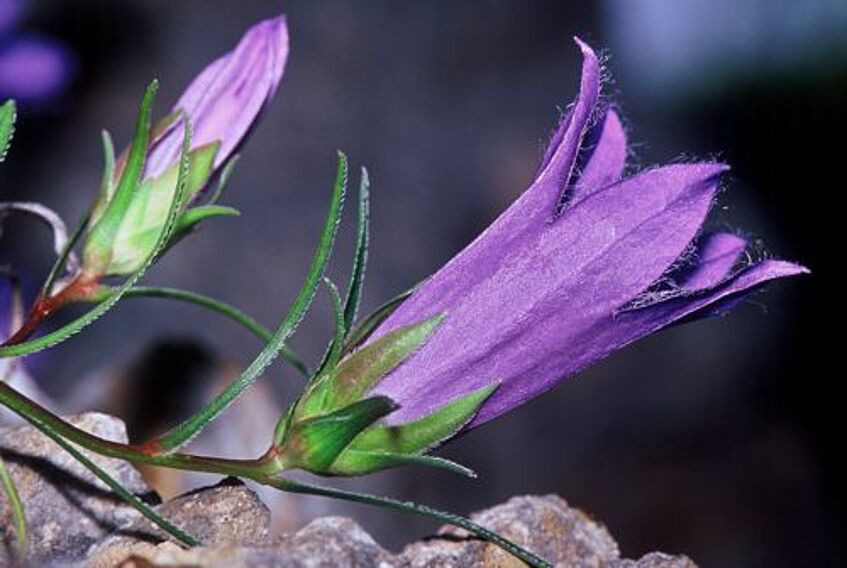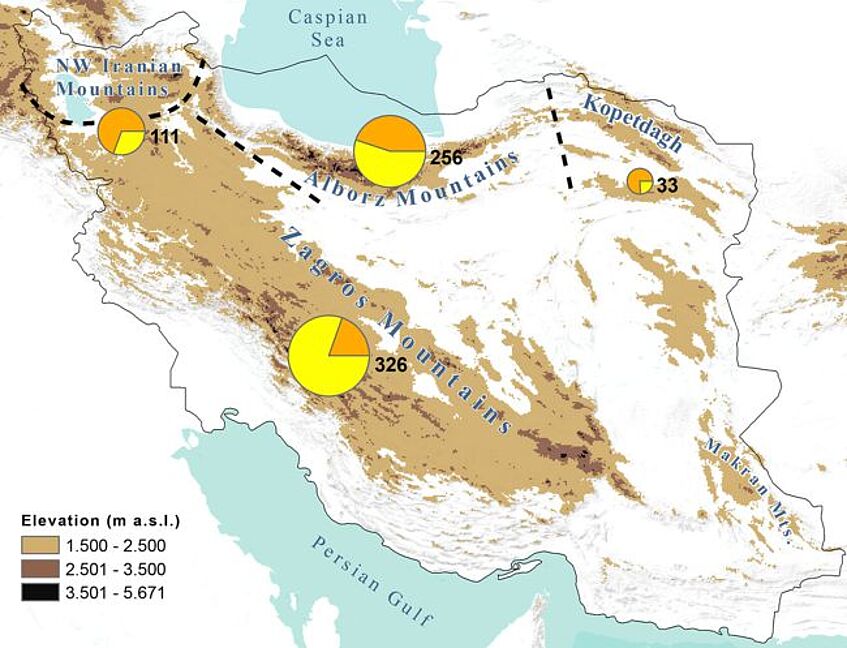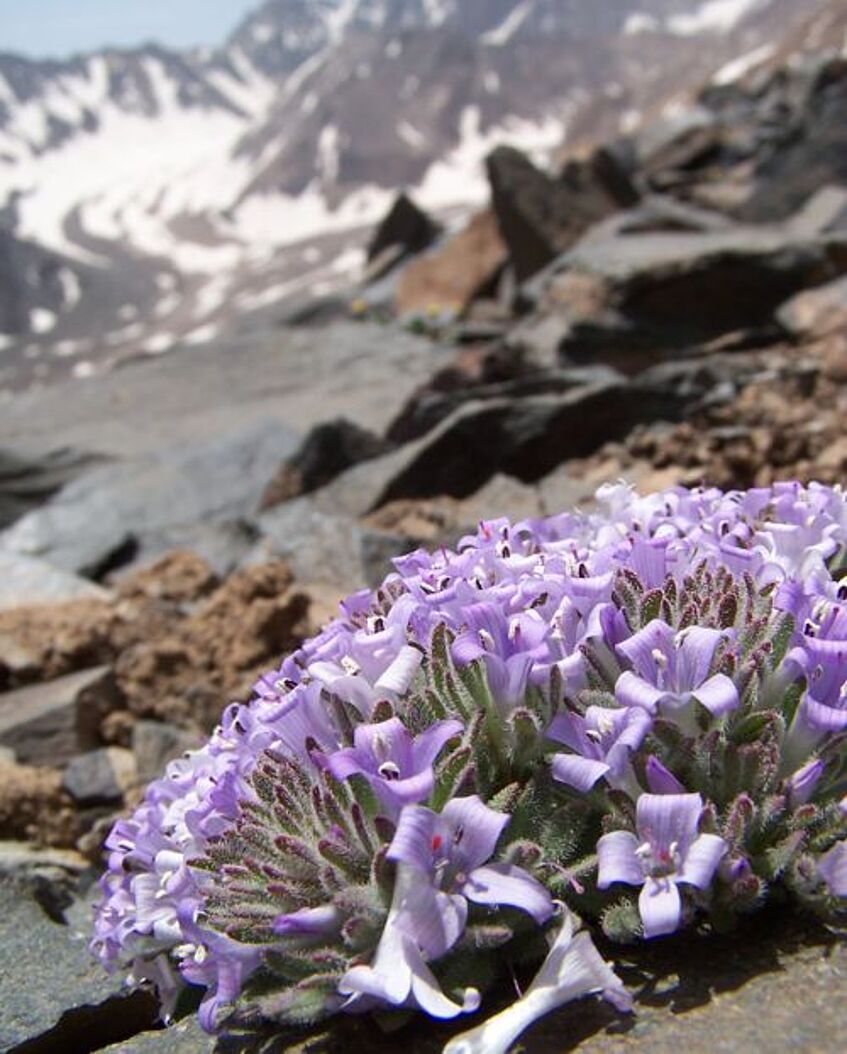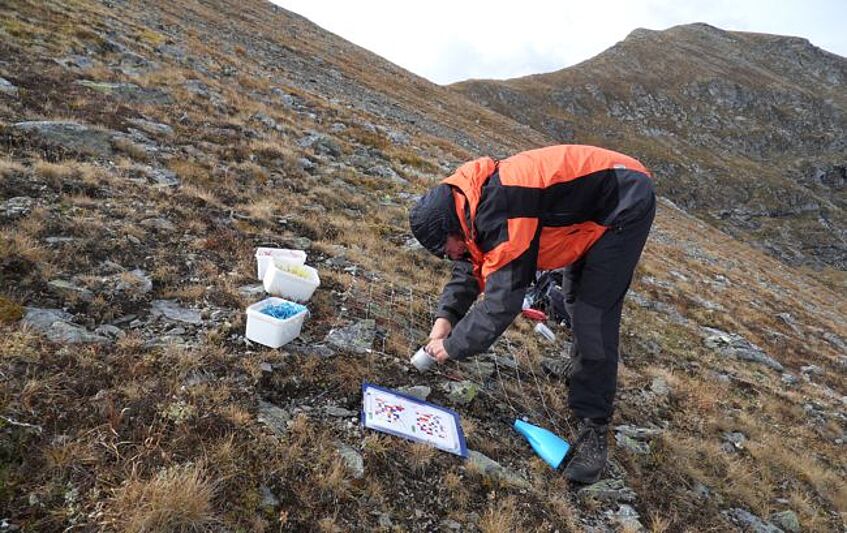Phylogeography

Genetic structure of Androsace helvetica

Edraianthus glisicii (photo: M. Sonnleitner)
Phylogeography
Pleistocene climate fluctuations had major impacts on the distribution and evolution of organisms. We are interested in inferring past and current range connectivity among and within European high mountain ranges (from the Iberian to the Balkan Peninsula) and beyond (especially with the Arctic), identifying patterns of Pleistocene range shifts (e.g., latitudinal versus altitudinal) including the location of refugia (e.g., nunataks) and their role for (re)colonization of formerly uninhabited regions, as well as addressing niche dynamics (niche conservatism versus niche evolution) in association with range shifts. To this end, we are employing varied molecular marker systems (DNA sequencing, AFLP fingerprinting, RADseq data) and ecological niche modeling and analyze those using state-of-the-art tools.
A group we have been intensively studying over the last years are European rock jasmines (Androsace sect. Aretia, Primulaceae). Its two dozen species, which are morphologically well-defined and share similar dispersal abilities and floral syndromes, show numerous biogeographic patterns, including widespread versus restricted or continuous versus disjoint distribution areas, rendering this group particularly suitable for investigating disjunctions on several geographical scales. Although each species or species-group has a highly idiosyncratic history, a few commonalities emerge, including the relevance of long distance dispersal sometimes involving counter-intuitive connections, high incidence of both ancient and current gene flow, and a decoupling of the degree of range fragmentation and its age.
Current research includes comparative phylogeography and niche evolution in selected species of sedges (Carex, Cyperaceae) and louseworts (Pedicularis, Orobanchaceae) from the eastern Alps to test whether ecological niches stay constant over time (niche conservatism) or not (niche evolution) and whether species of similar ecological requirements (e.g., Carex firma and Pedicularis rosea from wind-exposed limestone ridges; C. ferruginea and P. rostrato-spicata from sheltered snow-covered alpine swards) rather than species with similar pollination and dispersal biology (i.e., all Carex species versus all Pedicularis species) show similar phylogeographic patterns.
Selected Publications
- Schönswetter P, Schneeweiss GM (2019) Is the incidence of survival in interior Pleistocene refugia (nunataks) underestimated? Phylogeography of the high mountain plant Androsace alpina (Primulaceae) in the European Alps revisited. Ecology and Evolution 9: 4078–4086
- Surina B, Schneeweiss GM, Glasnović P, Schönswetter P (2014) Testing the efficiency of nested barriers to dispersal in the Mediterranean high mountain plant Edraianthus graminifolius (Campanulaceae). Molecular Ecology 23: 2861–2875
- Escobar García P, Winkler M, Flatscher R, Sonnleitner M, Krejčiková J, Suda J, Hülber M, Schneeweiss GM, Schönswetter P (2012) Extensive range persistence in peripheral and interior refugia characterizes Pleistocene range dynamics in a widespread Alpine plant species (Senecio carniolicus, Asteraceae). Molecular Ecology 21: 1255–1270
- Winkler M, Tribsch A, Schneeweiss GM, Brodbeck S, Gugerli F, Holderegger R, Abbott RA, Schönswetter P (2012) Tales of the unexpected: Phylogeography of the arctic-alpine model plant Saxifraga oppositifolia (Saxifragaceae) revisited. Molecular Ecology 21: 4618–4630
- Schneeweiss GM, Schönswetter P (2010) The wide but disjunct range of the European mountain plant Androsace lactea L. (Primulaceae) reflects late Pleistocene range fragmentation and post-glacial distributional stasis. Journal of Biogeography 37: 2016–2025
- Dixon C, Schönswetter P, Vargas P, Ertl S, Schneeweiss GM (2009) Bayesian hypothesis testing supports long-distance Pleistocene migrations in a European high mountain plant (Androsace vitaliana, Primulaceae). Molecular Phylogenetics and Evolution 53: 580–591
Iranian High Mountain Flora: Areas of Endemism and Phylogeography

Endemics in Iranian high mountains

Veronica paederotae (photo: J. Noroozi)
Iranian High Mountain Flora: Areas of Endemism and Phylogeography
Understanding patterns of how endemic species (i.e., species restricted in their distribution to an area) are distributed is relevant both for evolutionary biologists, ecologists and conservation biologists. Nevertheless, our knowledge on patterns of endemism is still limited even in widely recognized global biodiversity hotspots, including the Irano-Anatolian hotspot in southwestern Asia.
Focusing on Iran, which covers large parts of the Irano-Anatolian hotspot, areas of endemism (identified using data from Asteraceae only) were found to be strongly associated with high mountain ranges. Specifically, the number of endemic species peaks at mid-elevations, whereas the percentage of endemism gradually increases with elevation. This is likely due to high environmental heterogeneity and strong geographic isolation among and within mountain ranges.
Biodiversity loss due to human activities has dramatically increased over the last decades, and increased efforts to protect threatened species are needed. This is also the case for Iran, where hotspots of vascular plant endemism suffer from significant conservation gaps, as centres of unique plant diversity often are not within protected areas. Specifically, priority hotspots (i.e., centres of endemism congruently identified by all used biodiversity indices) harbour about half of the Iranian endemic plant species on only about 5% of the Iranian surface area, still half of those priority hotspots are not covered by nature reserves. In light of the growing pressure on these areas due to, for instance, global climate change or increasing anthropogenic land use establishment of new nature reserves and increased management efficacy of existing reserves are urgently needed.
An up-to-date account of diversity and distribution of the endemic species of Iran, based on data of more than 2500 species, emphasizes the importance of the Irano-Anatolian biodiversity hotspot (harbouring 84% of all endemic species) and of mountain ranges (harbouring three fourths of all endemic species) in general. Although the precise numbers will change over time due to taxonomic work, the overall patterns certainly will hold.
Whereas several mountain ranges, such as the European Alps, the Andes or the Hengduan mountains in China, have become model regions for studying the evolution and phylogeography of mountain plants, other mountain regions with high species diversity remain grossly understudied. One of those understudied regions is the Iranian Plateau. Although Pleistocene climatic fluctuations strongly affected biota also in areas not immediately affected by glaciations, such as southwestern Asia, little is known about the effects of these fluctuations on range dynamics of the mountain biota. In a current research project we want to assess the response of mountain plant species from different elevational belts of the Iranian Plateau to Pleistocene climatic oscillations.
Publications
- Noroozi J, Naqinezhad A, Talebi A, Doostmohammadi M, Plutzar C, Rumpf SB, Asgarpour Z, Schneeweiss GM (2019) Hotspots of vascular plant endemism in a global biodiversity hotspot in Southwest Asia suffer from significant conservation gaps. Biological Conservation 237: 299–307
- Noroozi J, Talebi A, Doostmohammadi M, Manafzadeh S, Asgarpour Z, Schneeweiss GM (2019) Endemic diversity and distribution of the Iranian vascular flora across phytogeographical regions, biodiversity hotspots and areas of endemism. Scientific Reports 9: 12991
- Noroozi J, Talebi A, Doostmohammadi M, Rumpf SB, Linder HP, Schneeweiss GM (2018) Hotspots within a global biodiversity hotspot - areas of endemism are associated with high mountain ranges. Scientific Reports 8: 10345
- Noroozi J, Körner C (2018) A bioclimatic characterization of high elevation habitats in the Alborz mountains of Iran. Alpine Botany 128: 1–11
Phylogeny and Taxonomy

Phylogeny of Phyteuma (photos: C. Pachschwöll)
Phylogeny and Taxonomy
Understanding evolution requires a solid phylogenetic framework that ideally would be translated into a taxonomic system. Consequently, much of our research in alpine plants has a strong phylogenetic and taxonomic component. For instance, studies in Alpine rock-jasmines (Androsace sect. Aretia, Primulaceae) focusing on phylogeography included establishing their phylogeny and the recognition of new taxa (species and subspecies). Likewise, studying factors responsible for the maintenance of mixed-ploidy populations of the Carniolian ragwort (Senecio carniolicus aggregate, Asteraceae) resulted in the taxonomic recognition of four species instead of one. Further studied groups include purple saxifrages (Saxifraga oppositifolia and relatives, Saxifragaceae), rampions (Phyteuma, Campanulaceae), leopard's banes (Doronicum, Asteraceae), or saw-worts (Saussurea, Asteraceae).
Selected Publications
- Skof S, Álvarez I, Pachschwöll C, Schneeweiss GM (2019) Phylogeny and biogeography of the narrowly endemic Doronicum cataractarum (Asteraceae) from the eastern European Alps: Pleistocene origin from Alpine ancestors rather than Tertiary relic with southwest Asian affinity. Plant Systematics and Evolution 305: 139–149
- Flatscher R, Escobar García P, Hülber K, Sonnleitner M, Winkler M, Saukel J, Schneeweiss GM, Schönswetter P (2015) Underestimated diversity in one of the world's best studied mountain ranges: The polyploid complex of Senecio carniolicus (Asteraceae) contains four species in the European Alps. Phytotaxa 213: 1–21
- Schönswetter P, Magauer M, Schneeweiss GM (2015): Androsace halleri subsp. nuria Schönsw. & Schneew. (Primulaceae), a new taxon from the eastern Pyrenees (Spain, France). Phytotaxa 203: 227–232
- Schneeweiss GM, Pachschwöll C, Tribsch A, Schönswetter P, Barfuss MHJ, Esfeld K, Weiss-Schneeweiss H, Thiv M (2013) Molecular phylogenetic analyses identify Alpine differentiation and dysploid chromosome number changes as major forces for the evolution of the European endemic Phyteuma (Campanulaceae). Molecular Phylogenetics and Evolution 69: 634–652
- Winkler M, Tribsch A, Schneeweiss GM, Brodbeck S, Gugerli F, Holderegger R, Schönswetter P (2013) Strong nuclear differentiation contrasts with widespread sharing of plastid DNA haplotypes across taxa in European purple saxifrages (Saxifraga sect. Porphyrion subsect. Oppositifoliae). Botanical Journal of the Linnean Society 173: 622–636
- Schneeweiss GM, Schönswetter P, Kelso S, Niklfeld H (2004) Complex biogeographic patterns in Androsace (Primulaceae) and related genera: evidence from phylogenetic analyses of nuclear ITS and plastid trnL-F sequences. Systematic Biology 53: 856–876
Polyploid Evolution

Fieldwork (photo: M. Sonnleitner)

Senecio carniolicus s. str. (photo: M. Sonnleitner)
Polyploid Evolution
Polyploidy is a major driver of plant diversification and speciation, and alpine plants are no exception. While we have studied the origin of polyploids in a number of alpine plant groups, such as rock jasmines (Androsace sect. Aretia, Primulaceae) or leopard's-banes (Doronicum, Asteraceae), our focus in recent years has been in the Carniolian ragwort (Senecio carniolicus s. l. [syn. Jacobaea carniolica s. l.], Astercaeae). In the eastern European Alps, this complex comprises four species: two allopatric diploids, the western S. insubricus and the eastern S. noricus; the tetraploid S. disjunctus with a strongly disjoint distribution range, and the most widespread hexaploid S. carniolicus s. str. In many parts of the Alps, two (most often one of the diploid species, S. insubricus or S. noricus, and the hexaploid S. carniolicus s. str.) or even three species (as before, but additionally with S. disjunctus) are growing in close proximity. Apart from defining these species both morphologically and genetically (including inference of the origin of the polyploids), we investigated factors responsible for the maintenance of species integrity in areas of sympatry, focusing on habitat differentiation and crossability (fruit set, germination rates).
Cytotype diversity is common in Alpine plants and in many cases under-appreciated. A recent survey focusing on two narrowly endemic diploid eyebright species (Euphrasia inopinata, E. sinuata) revealed that diploid cytotypes are also present in E. minima, a widespread mostly tetraploid species (presumably of allotetraploid origin).
Selected Publications
- Pan D, Schönswetter P, Moser T, Vitek E, Schneeweiss GM (2019) Ancestral remnants or peripheral segregates? Phylogenetic relationships of two narrowly endemic Euphrasia species (Orobanchaceae) from the eastern European Alps. AoB Plants 11(2): plz007
- Sonnleitner M, Hülber K, Flatscher R, Escobar García P, Winkler M, Suda J, Schönswetter P, Schneeweiss GM (2016) Ecological differentiation of diploid and polyploid cytotypes of Senecio carniolicus s.l. (Asteraceae) is stronger in areas of sympatry. Annals of Botany 117: 269–276
- Pachschwöll C, Escobar García P, Winkler M, Schneeweiss GM, Schönswetter P (2015) Polyploidisation and geographic differentiation drive diversification in a European high mountain plant group (Doronicum clusii aggregate, Asteraceae). PLoS ONE 10(3): e0118197
- Sonnleitner M, Weis B, Flatscher R, Escobar García P, Suda J, Krejčiková J, Schneeweiss GM, Winkler M, Schönswetter P, Hülber K (2013) Parental ploidy strongly affects offspring fitness in heteroploid crosses among three cytotypes of autopolyploid Jacobaea carniolica (Asteraceae). PLoS ONE 8(11): e78959
- Weiss-Schneeweiss H, Blöch C, Turner B, Villaseñor JL, Stuessy TF, Schneeweiss GM (2012) The promiscuous and the chaste: frequent allopolyploid speciation and its genomic consequences in American daisies (Melampodium sect. Melampodium; Asteraceae). Evolution 66: 211–228
- Dixon CJ, Schönswetter P, Suda J, Wiedermann MM, Schneeweiss GM (2009) Reciprocal Pleistocene origin and postglacial range formation of an allopolyploid and its sympatric ancestors (Androsace adfinis group, Primulaceae). Molecular Phylogenetics and Evolution 50: 74–83
